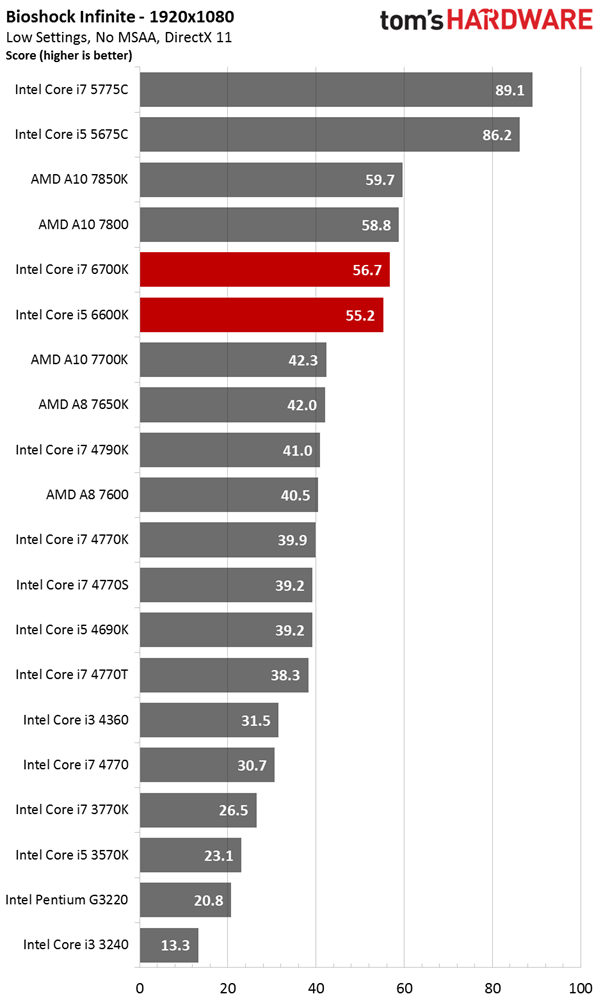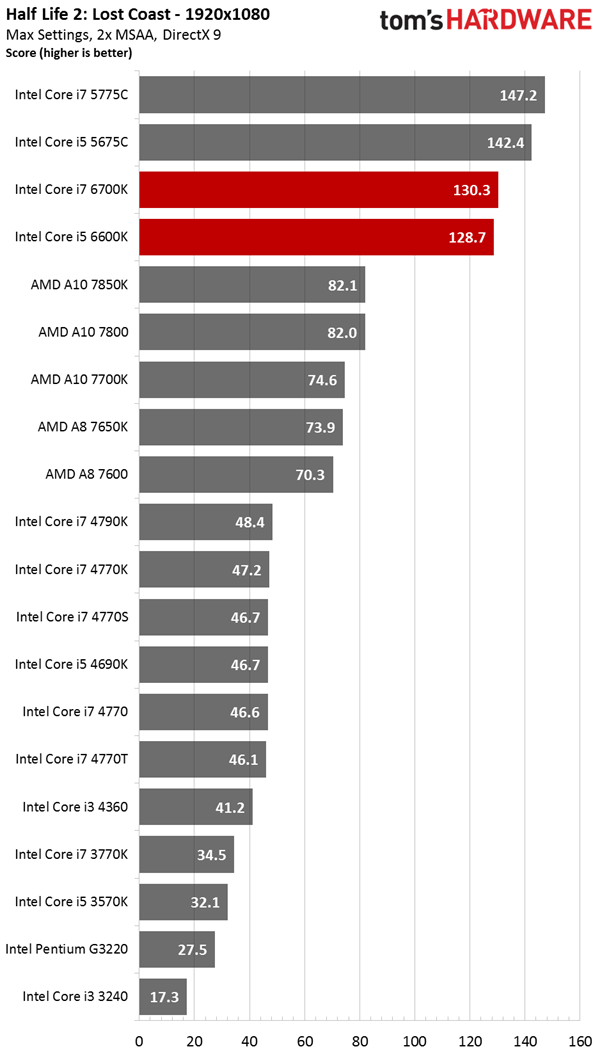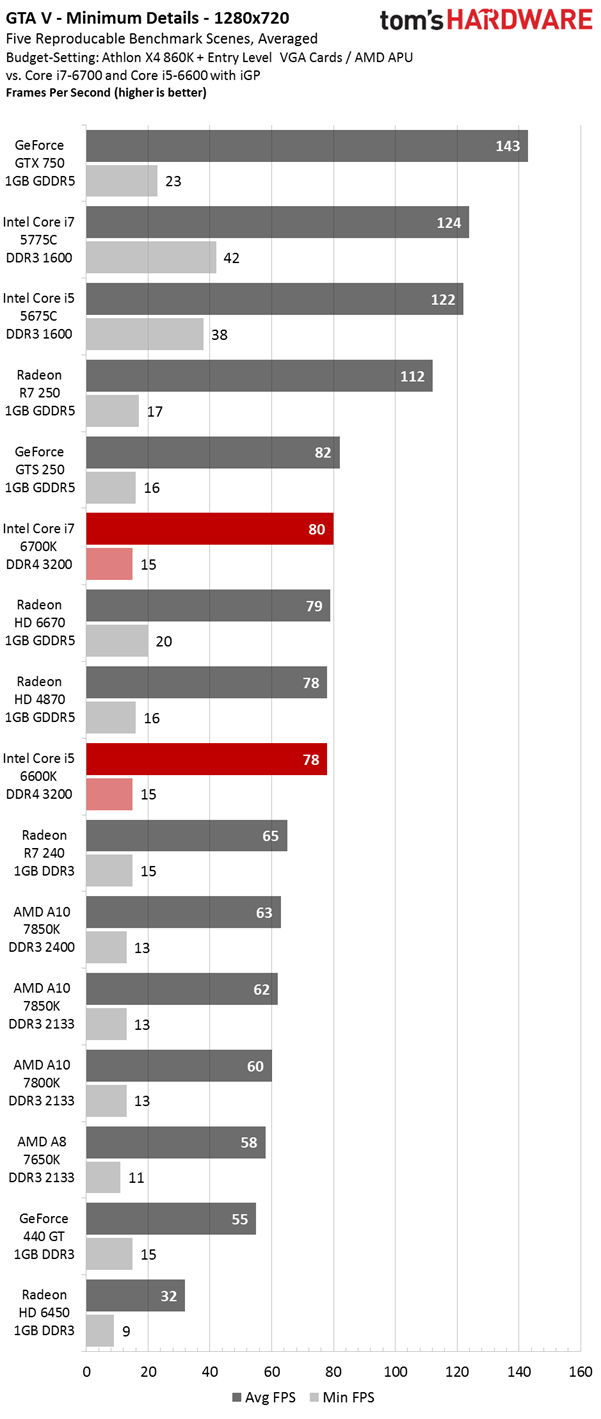Skylake: Intel's Core i7-6700K And i5-6600K
Intel gave us an early look at the Core i7-6700K, i5-6600K and Z170 chipset two weeks ahead of IDF and the unveiling of Skylake's architectural details.
HD Graphics 530: Gaming
Bioshock Infinite @ 1920x1080 (DirectX 11)
Bioshock Infinite is no heavyweight when it comes to graphics load. Still, even after we picked the game's low settings, the integrated graphics engine (and not the IA cores), limited performance.
We are disappointed to see Intel take a big step backward here. After enabling stellar frame rates from the 65W C-series Broadwell processors, the company neuters its enthusiast-oriented 95W Skylake CPUs with HD Graphics 530, based on the GT2 configuration. Consequently, the results we measure are a lot worse than what we saw a couple of months ago:
In spite of this, and partly due to its much faster x86 cores, Intel’s new offerings keep pace with AMD’s best APUs, if just barely. Then again, AMD enjoys a substantial price advantage. To be sure, you won't want Core i7-6700K or Core i5-6600K for their 3D capabilities.
Half Life 2: Lost Coast @ 1920x1080 (DirectX 9)
Half Life may be old, but it does represent a challenge for most IGPs, giving us the opportunity to evaluate playable games on entry-level graphics hardware. We’re using 2x MSAA, so the host processing complex isn’t stressed too much.
There’s a marked increase in performance compared to the Core i7-4790K’s HD Graphics 4600. The new processors also narrow the performance gap between Iris Pro 6200 seen in our Bioshock Infinite benchmark.
Grand Theft Auto V — Welcome To The Entry Level
This chart compares a system with an inexpensive CPU and entry-level or older graphics cards to AMD’s current APUs and Intel’s two Skylake CPUs running integrated graphics.
Broadwell’s Iris Pro 6200 had us flying high, and the two Skylake CPUs have us crashing back to the ground. The reason that AMD’s APUs are still within reach is that their x86 cores are much weaker, get overwhelmed by GTA V and severely bottleneck the integrated graphics.
Get Tom's Hardware's best news and in-depth reviews, straight to your inbox.
Intel's decision to step back (and down) on graphics compared to Broadwell certainly leaves a noticeable mark on the results. Then again, most enthusiasts aren't going to buy one of these unlocked processors and use its graphics engine for anything other than its Quick Sync functionality. Instead, they'll drop in a more powerful discrete card.
Although we certainly enjoyed seeing what the Core i7-5770C could do without the help of an add-in board, most of our readers correctly countered that dedicating a lot of transistors to integrated graphics would be a waste in a gaming PC.
Current page: HD Graphics 530: Gaming
Prev Page Results: Workstation Applications Next Page HD Graphics 530: Workstation
Igor Wallossek wrote a wide variety of hardware articles for Tom's Hardware, with a strong focus on technical analysis and in-depth reviews. His contributions have spanned a broad spectrum of PC components, including GPUs, CPUs, workstations, and PC builds. His insightful articles provide readers with detailed knowledge to make informed decisions in the ever-evolving tech landscape
-
rantoc Yawn... its easy to see that intel have to little competition, they have stagnated in the cpu performance department!Reply -
Vlad Rose What the heck Intel? So, you provide great integrated graphics into Broadwell, then nerf it for Skylake? I guess you had to find a way to help sell your 'paper launch' of Broadwell. I really hope Xen makes you guys wake up; although it more than likely won't.Reply -
Bartendalot At least Skylake HEDT should be powerful. Unless DX12 pulls a rabbit out of a hat, this doesn't look promising for anyone who has Sandy or higher.Reply -
stairmand ReplyStill 4 cores.... Im sticking to my Q6600.
Then you really are missing out, 4 cores or not a current i5 (let alone an i7) will simply destroy the old Q6600 C2Q. It was great in the day but it's very old hat now and the lack of features on the board worse still. -
salgado18 ReplyStill 4 cores.... Im sticking to my Q6600.
You do know that your Q6600 is astronomically slower than Skylake in every single department, right? By your logic, the Phenom II X6 is better than the i7 6700K.
I think you should consider upgrading. You won't regret, promise. -
salgado18 ReplyWhat the heck Intel? So, you provide great integrated graphics into Broadwell, then nerf it for Skylake? I guess you had to find a way to help sell your 'paper launch' of Broadwell. I really hope Xen makes you guys wake up; although it more than likely won't.
Do you mean Shen, from LoL? Or Zen? XD
I believe the cost of the integrated memory chips would make these processors too expensive and niche to be viable products.
-
Lmah Good upgrade for 1st Gen i5/i7 users. Though I think they targeted it at the 2nd Gen i5/i7 users, doesn't seem like a huge improvement for them though.Reply


